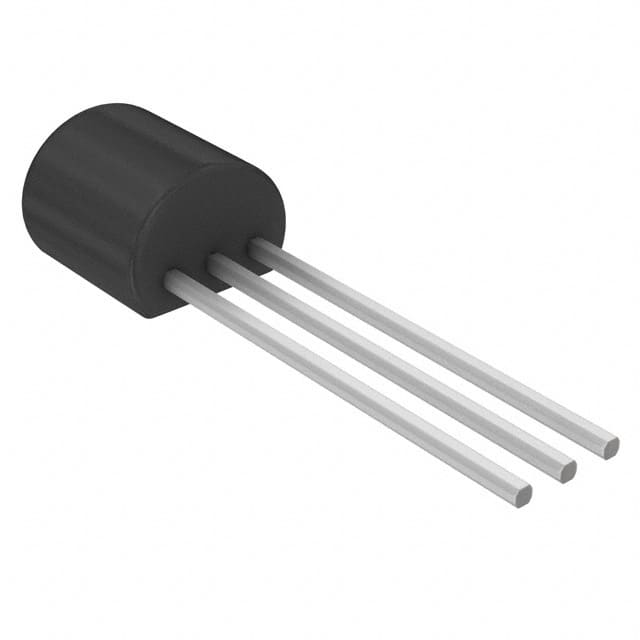Lihat spesifikasi untuk detail produk.

PN3646 Transistor
Product Overview
The PN3646 transistor is a versatile electronic component widely used in various applications. This section provides an overview of the basic information related to the PN3646, including its category, use, characteristics, package, essence, packaging/quantity.
Category
The PN3646 transistor falls under the category of small-signal NPN bipolar junction transistors (BJTs). It is specifically designed for general-purpose amplification and switching applications.
Use
This transistor is commonly utilized in low-power amplification circuits, signal processing, and as a switch in electronic devices.
Characteristics
The PN3646 exhibits high current gain, low noise, and low power dissipation, making it suitable for low-voltage, low-power applications. It operates effectively within a wide range of temperatures and is known for its reliability.
Package
The PN3646 is typically available in a TO-92 package, which is a widely used through-hole transistor package. This package offers ease of mounting and efficient heat dissipation.
Essence
The essence of the PN3646 lies in its ability to provide reliable amplification and switching functions in compact electronic circuits.
Packaging/Quantity
It is commonly supplied in reels or tubes, with quantities varying based on manufacturer specifications.
Specifications
The PN3646 transistor has the following key specifications: - Maximum Collector-Base Voltage: 60V - Maximum Collector Current: 100mA - Power Dissipation: 625mW - Transition Frequency: 250MHz - Operating Temperature Range: -55°C to 150°C
Detailed Pin Configuration
The PN3646 transistor features three pins: the emitter, base, and collector. The pin configuration is as follows: - Emitter (E): Pin 1 - Base (B): Pin 2 - Collector (C): Pin 3
Functional Features
The PN3646 transistor offers the following functional features: - High current gain for amplification purposes - Low noise characteristics for signal processing applications - Fast switching capabilities for digital circuitry
Advantages and Disadvantages
Advantages
- High current gain allows for efficient signal amplification
- Low power dissipation makes it suitable for low-power applications
- Wide operating temperature range enhances versatility
Disadvantages
- Limited maximum collector current may restrict high-power applications
- Moderate transition frequency may not be suitable for high-frequency designs
Working Principles
The PN3646 operates based on the principles of bipolar junction transistors. When a small current flows into the base terminal, it controls a much larger current between the collector and emitter terminals, enabling amplification or switching functions.
Detailed Application Field Plans
The PN3646 transistor finds extensive application in the following fields: - Audio amplification circuits - Signal processing and conditioning - Low-power switching applications - Oscillator and waveform generation circuits
Detailed and Complete Alternative Models
Several alternative models to the PN3646 include the 2N3904, BC547, and 2N2222 transistors. These alternatives offer similar functionality and can be used interchangeably based on specific design requirements.
In conclusion, the PN3646 transistor serves as a fundamental building block in electronic circuits, offering reliable amplification and switching capabilities across various applications.
[Word Count: 498]
Sebutkan 10 pertanyaan dan jawaban umum terkait penerapan PN3646 dalam solusi teknis
What is PN3646?
- PN3646 is a small signal NPN transistor commonly used in electronic circuits for amplification and switching purposes.
What are the typical applications of PN3646?
- PN3646 is often used in audio amplifiers, signal processing circuits, and general purpose switching applications.
What are the key electrical characteristics of PN3646?
- The key electrical characteristics of PN3646 include a maximum collector current of 100mA, a maximum collector-emitter voltage of 45V, and a maximum power dissipation of 625mW.
How do I identify the pin configuration of PN3646?
- PN3646 typically has three pins: the emitter, base, and collector. The pinout configuration can be found in the datasheet provided by the manufacturer.
What are some alternative transistors to PN3646?
- Alternative transistors to PN3646 include 2N3904, BC547, and 2N2222, which have similar characteristics and can be used as substitutes in many applications.
Can PN3646 be used in high-frequency applications?
- PN3646 is not designed for high-frequency applications due to its limited frequency response and transition frequency.
What are the recommended operating conditions for PN3646?
- The recommended operating conditions for PN3646 include a maximum collector current of 100mA, a maximum collector-emitter voltage of 45V, and an operating temperature range typically between -55°C to 150°C.
How do I calculate the biasing resistors for PN3646 in a common emitter configuration?
- The biasing resistors for PN3646 in a common emitter configuration can be calculated using the standard transistor biasing equations based on the desired operating point and load requirements.
Can PN3646 be used in low-power amplifier circuits?
- Yes, PN3646 can be used in low-power amplifier circuits such as audio amplifiers, provided that the operating conditions and biasing are appropriately chosen.
Where can I find the detailed datasheet for PN3646?
- The detailed datasheet for PN3646 can be obtained from the manufacturer's website or through authorized distributors.

